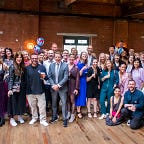Taming the elusive beast
Fostering creativity and innovation.
As the UK starts to emerge from lockdown and many organisations move away from 9 to 5 and look towards a hybrid future — one of the questions businesses are grappling with is how they can continue to be creative and innovative when they’re no longer together. We know it’s important; we’ve seen it time and time again throughout the pandemic; those who are bold, innovate and adapt quickly have emerged strongest. So how might you recreate those vital collaboration sessions and continue to innovate remotely without whiteboards and workshops, post-its and pitches, brainstorming and breakout sessions?
Along with many in the creative industries, working in a Design Consultancy like Magnetic meant we were tipped pretty quickly into the deep end of making this new model work. We’re used to working with uncertainty and were able to quickly adapt to help businesses we work with continue to work on projects remotely, and more recently to reimagine how they work in the hybrid world.
In the beginning we grappled with how to recreate the interaction and energy that feeds creativity and innovation — that magic you get from being together. Getting the right group of people together in the right space and with the right direction is an absolutely brilliant way to create new things. It’s probably the best way there is. But it’s not the only way. We soon discovered the hybrid future is not about throwing away everything we’ve learned about creativity — it is about recognising that we’re going to need to find new ways of achieving these results virtually for the times and the groups that we can’t bring together in-person. These new digital ways of working complement our in-person approaches, and often unlock new opportunities.
So here’s three thoughts from our own creative experiences over the last 12 months:
Mindfulness. To be creative people need to feel excited, inspired, bold. The pandemic has been hard on those emotions. It’s important to remember- future hybrid working won’t be the same as how we’re all working remotely in the pandemic. These emotions will slowly return if you take care of and nurture your teams. Don’t expert instant miracles, but do think about building those emotions back. Mindfulness can help. We’re seeing companies like Google and Ford bring mindfulness practices into the workplace, as many studies suggest mindfulness meditation can boost creativity and innovation. We’re also seeing these practices more at Board level — with Linkedin CEO Jeff Weiner recently credit meditation in helping him strategise. With a few simple practices you can see your teams find new ways of being creative with new ideas to tackle every day tasks and even the big stuff — the hairy questions that haven’t gone away.
Ideas are not the problem. After 20 years working in product development and innovation it’s clear that lack of ideas is never actually the problem. Humans are hard-wired to have ideas, to improve things and to evolve. It’s just that creativity and innovation can be an elusive beast. It’s well documented that most people get their best ideas when their brain is relaxed — often in the shower that morning! Then as you instantly log into Zoom to brainstorm, all the ideas tend to run away. As a leader you can help by creating a fabric for having ideas and discussing those ideas — simply by making brainstorming sessions less formal and creating time together that’s not scripted to encourage ideation. An awful lot of good ideas started over a sandwich, or a walk to lunch, or a drink after work, it’s helpful to think about replicating some of that ‘casual but slightly serious’ time in smaller groups, perhaps encouraging the spontaneity of chance encounters in the office. Think about walking meetings over a good old fashioned phone call or Zoom roulette where anyone can turn up and be paired with a colleague at random to catch up, bounce ideas or talk about a specific problem that needs solving.
Imagine your business as an ideas factory — how does an idea travel through it? Idea development has changed a lot in the hybrid world. Rituals and time-together are much rarer and more precious. Idea development has always been a process — that’s not to say every idea isn’t unique, but it is saying you must have a clear process for developing ideas to become consistently good at product development (=innovation). If you walked into Magnetic’s busy studio pre-C19 it was sometimes hard to define that exact process and still it didn’t matter because everyone was there and simple osmosis and chatter kept the process together — the ideas were plastered over the walls, whiteboards and tables, in clear sight to digest and build on. Hybrid working changes that, so you really need to think about how everyone can share the same picture as an idea develops — a good digital whiteboard tool is critical to this, thankfully after 20 years of waiting there’s suddenly a few of these around — our favoured choice is the excellent Miro.
The organisations that purposefully re-imagine the way they work will have a critical advantage over those that stumble into it unwillingly, and those more willing to be bold and to experiment will get there quicker than their competitors.
Best wishes for your journey.
Author: Richard Poole
Magnetic is a design and innovation company that helps design better futures. We’ve worked with global businesses to build capabilities, products, services and transform organisations. If you’d like to find out more about our capability building drop us a line.
